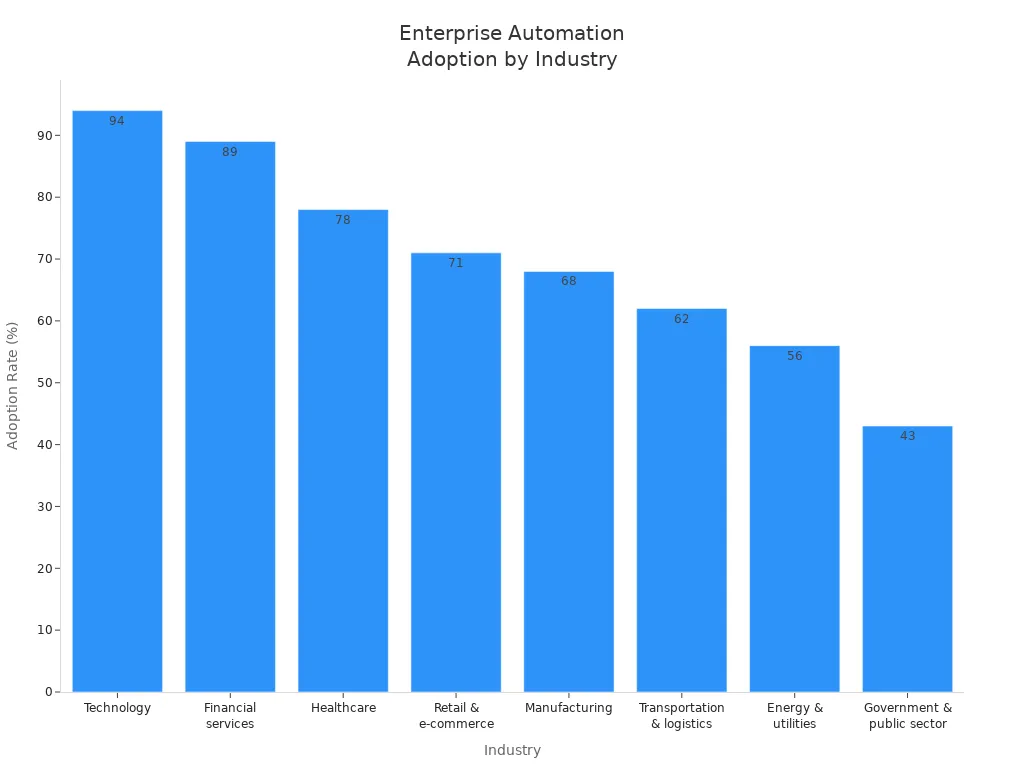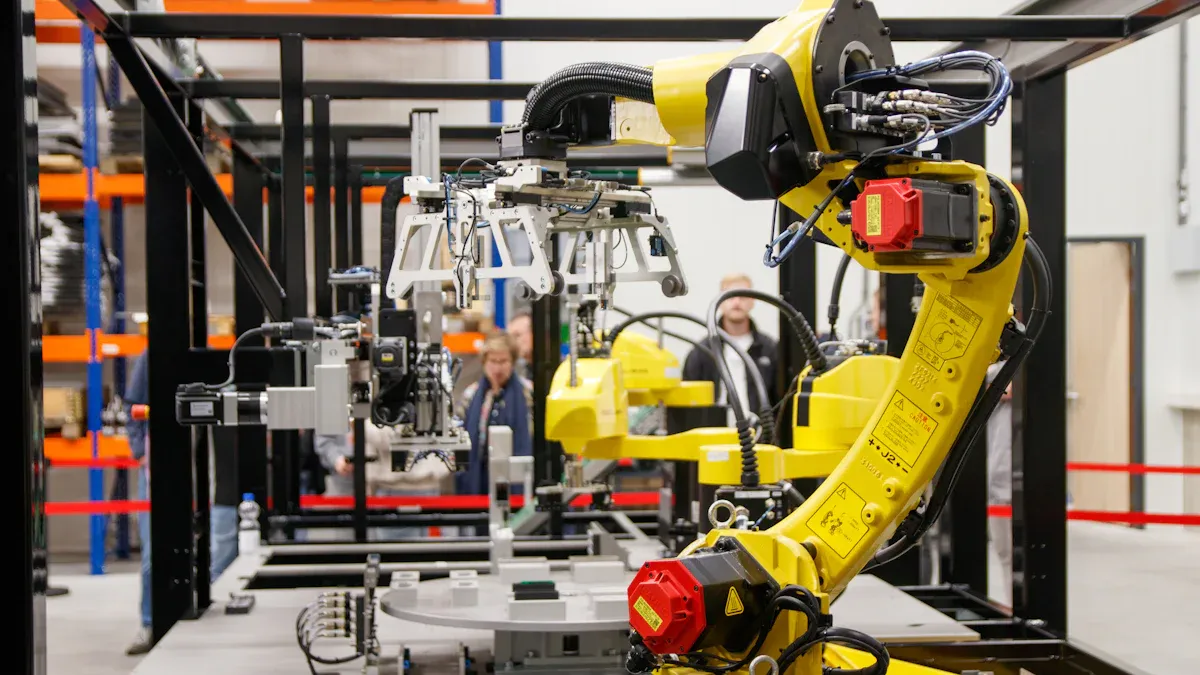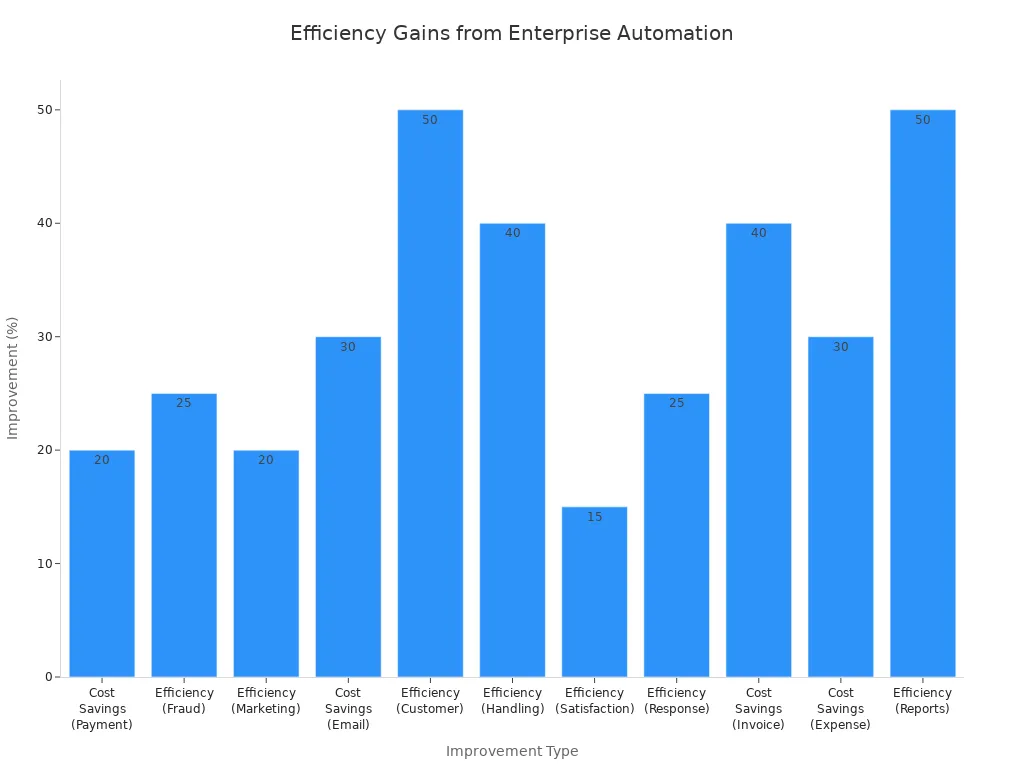Enterprise Automation: Opportunities & Challenges

Enterprise Automation uses technology to handle tasks that people once did by hand. Many companies now use automation to work faster and save money. You can see its impact in almost every industry. For example, in technology, 94% of companies use automation for software development, while 89% of financial firms use it for fraud detection. Check the chart below to see how adoption rates differ:

Understanding both the benefits and the challenges will help you make smart choices. Automation can make your work more efficient and reduce costs. Many businesses report lower expenses and better results after starting automation. Think about how these changes could help your team and shape your company’s future.
Key Takeaways
Enterprise Automation improves efficiency by handling repetitive tasks, allowing teams to focus on more important work.
Automation can lead to significant cost savings, with companies reporting reductions in manual processing costs and improved operational efficiency.
Implementing automation requires careful planning and readiness assessments to ensure your business can adapt to new technologies.
Security is crucial in automation; strong access controls and regular risk assessments help protect sensitive data from cyber threats.
Training and support for employees are essential to ease the transition to automation and to help them adapt to new roles.
Enterprise Automation Overview

Definition
Enterprise Automation means using technology to complete tasks that people used to do by hand. You can use it to make your business run faster and with fewer mistakes. It covers many parts of your company, from collecting data to making decisions and taking action. Here are the main steps in how Enterprise Automation works:
Data Collection: You gather information from sensors, user inputs, or other systems.
Data Processing: You clean and organize the data so it is ready to use.
Analysis & Decision-Making: AI and machine learning tools look for patterns or problems in the data.
Action Triggering: The system starts actions, like sending alerts or updating records.
Execution & Feedback: The system does the tasks and checks if they worked well.
Reporting & Optimization: You get reports that show what worked and what can be better next time.
Enterprise Automation uses both hardware and software. Hardware includes servers, sensors, and devices that collect data. Software includes automation platforms, robotic process automation tools, and AI programs. These work together to help your business run smoothly.
Importance
You need Enterprise Automation to stay ahead in today’s fast-changing world. It helps you save time and money by reducing the need for people to do simple, repetitive tasks. When you use automation, your team can focus on more important work. Over 90% of workers say they get more done with automation, and almost 90% feel happier at work.
According to a report by the Economist Intelligence Unit, automation is central to digital transformation, with 51% of business leaders using it a lot.
Enterprise Automation also helps you make better decisions. AI can predict trends and customer needs, so you can plan ahead. Automation also cuts down on mistakes, which means your reports and results are more accurate. When you connect your systems, you can give customers a better experience and let your staff focus on creative tasks.
Technologies

RPA
Robotic Process Automation (RPA) helps you automate simple, repetitive tasks. Many companies use RPA to speed up both front and back-office work. You can use RPA to gather customer data, send emails, or process invoices. This technology increases efficiency and reduces mistakes. Employees get more time to solve customer problems or work on creative projects. RPA also lowers costs, such as those for accounting.
RPA tools have a non-intrusive and flexible design. You can add them to your current systems without big changes.
Here are some common RPA use cases and their benefits:
Use Case Description | Benefits |
|---|---|
Automating repetitive tasks in front and back offices | Increases efficiency and reduces human error |
Gathering customer data from different systems | Streamlines data management and improves customer service |
Sending pre-approved email templates to customers | Enhances communication speed and consistency |
AI
Artificial Intelligence (AI) brings smart decision-making to Enterprise Automation. You can use AI to analyze data, predict trends, and make better choices. For example, IBM used AI RPA in finance and saved thousands of hours. Transaction speeds improved by up to 80%. Coca-Cola used AI to forecast demand and improved accuracy by over 20%. AI helps you work faster and smarter.
AI and machine learning are among the most widely adopted technologies in automation.
AI lets you spot patterns and solve problems before they grow.
Cloud
Cloud technology makes it easy for you to scale automation as your business grows. You can manage bots and workflows from one dashboard. Cloud platforms connect with other systems, like ERP or CRM, using APIs. This helps you experiment and adapt quickly.
Benefit | Description |
|---|---|
Scalability | Easily scale bots and workflows during peak demand. |
Centralized management | Monitor performance, usage, and exceptions from a unified dashboard. |
API-first integrations | Seamless connection with cloud-based systems. |
Rapid experimentation | Support for rapid experimentation and iteration. |
Cloud automation boosts productivity. Your team can focus on important projects while the system handles routine work.
IoT
Internet of Things (IoT) devices collect and share data in real time. You can use IoT to track products, monitor equipment, and improve safety. In manufacturing and logistics, IoT helps you see where items are and how they move. It also keeps products safe and reduces costs.
IoT improves supply chain visibility and efficiency.
Real-time monitoring helps you plan better and respond faster.
Predictive maintenance reduces downtime and increases reliability.
IoT devices help you make smart choices and keep your operations running smoothly.
Trends
Hyperautomation
You see hyperautomation changing how companies work every day. Hyperautomation combines tools like RPA, AI, and machine learning to handle tasks that used to need people. You can use it in many areas, such as banking, insurance, and sales. For example, banks use hyperautomation to speed up payment operations and make regulatory reporting easier. Insurance companies use it to process claims faster. You also find hyperautomation helping HR teams make better decisions and keep employees happy. Many businesses now use Hyperautomation as a Service, which lets you try these tools without spending a lot at first. Collaborative robots, or CoBots, work with people to finish repetitive jobs. Today, there are about 99 CoBots for every 10,000 workers worldwide.
Over 90% of employees say automation makes their work better, and 85% see improved teamwork.
Low-Code/No-Code
Low-code and no-code platforms let you build apps and automate tasks without deep coding skills. You can become a "citizen developer" and help your company move faster. By 2024, experts expect over 65% of app development to use low-code methods. These platforms help you finish projects up to ten times faster than traditional ways. The market for these tools keeps growing, with a 22.6% jump in adoption from 2020 to 2021. By 2025, you might see 70% or more of all new apps built this way.
You save time and money.
You do not need to wait for IT teams.
You can solve problems quickly.
Intelligent Workflows
Intelligent workflows use real-time data to help you make better choices and work faster. You can see fewer mistakes and less rework because the system checks your work as you go. These workflows also help you follow rules and keep good records. As your business grows, intelligent workflows scale with you. They help you serve customers faster and keep your team focused on important tasks.
Benefit | Description |
|---|---|
Faster decision-making | Real-time data helps you decide quickly. |
Reduced errors and rework | The system checks for mistakes and fixes them. |
Enhanced compliance and audit | Keeps records for easy checks and audits. |
Scalable operations | Grows with your business needs. |
Improved customer experiences | Solves customer issues faster. |
Increased employee productivity | Frees your team for more valuable work. |
Data-driven insights and optimization | Gives you reports to help you improve. |
Enterprise Automation brings all these trends together, helping you stay ahead in a fast-changing world.
Opportunities
Efficiency
You can make your business run faster and smoother with automation. When you use technology to handle tasks, you cut down on mistakes and save time. Many companies see big improvements in how quickly they finish work. For example, you can reduce response times by half and cut the time needed to create reports by 50%. You also see a 40% drop in how long it takes to handle tasks. These changes help your team focus on important projects.
Improvement Type | Expected Improvement |
|---|---|
Cost Savings (Payment) | 20% reduction in manual payment costs |
Efficiency (Fraud) | 25% reduction in fraud incidents |
Efficiency (Marketing) | 20% improvement in click-through rates |
Cost Savings (Email) | 30% reduction in manual email costs |
Efficiency (Customer) | |
Efficiency (Handling) | 40% reduction in average handling time |
Efficiency (Satisfaction) | 15% increase in customer satisfaction |
Efficiency (Response) | 25% increase in response rates |
Cost Savings (Invoice) | 40% reduction in manual invoice costs |
Cost Savings (Expense) | 30% reduction in manual expense costs |
Efficiency (Reports) | 50% reduction in report generation time |

Tip: When you automate tasks, you give your team more time to solve problems and help customers.
Cost Reduction
You can save a lot of money by using automation. Many large companies have already seen big savings. For example, American Express saved $2 billion by using AI to spot fraud. JPMorgan Chase saved 360,000 hours by using a platform to review legal documents. Abingdon & Witney College saved 1,665 hours by digitizing their workflows. These savings come from doing tasks faster and needing fewer people for simple jobs.
| Company | Documented Savings | Description | |---|---| | American Express | $2 billion in fraud prevention | Uses AI to analyze transactions. | | Abingdon & Witney College| 1,665 hours saved | Digitized workflows for administrative tasks. | | Downer | 3,350 hours saved | Automated 23 processes, improving efficiency. | | JPMorgan Chase | 360,000 hours saved | COiN platform reviews legal documents quickly. | | Bank of America | 1.5 billion customer interactions | Erica virtual assistant reduces need for live agents.| | Healthcare Payer | $15 million in total savings | Improved process variability and workforce capacity.| | Skan AI | $13 million in estimated savings | Reduced call processing time and improved sales conversion. |
Note: You can use automation to lower costs in many areas, such as payments, emails, invoices, and expenses.
Scalability
You can grow your business without adding more people when you use automation. Technology helps you handle more work and serve more customers. You do not need to worry about manual tasks slowing you down. Automation lets you:
Remove repetitive jobs so your team can focus on bigger goals.
Save time by automating data entry and inventory checks.
Use chatbots and AI to answer customer questions quickly.
Give your agents more time for complex problems.
Modernize old systems and speed up decisions.
Tip: Automation helps you keep up with demand as your business grows.
Compliance
You can follow rules and avoid fines more easily with automation. Many industries have strict rules, and mistakes can cost a lot. Automation helps you:
Compliance Benefit | Description |
|---|---|
Reduced Compliance Risks | Automation minimizes human error, lowering the risk of fines or non-compliance. |
More Efficient Than Manual Processes | Automated workflows speed up compliance processes, allowing focus on strategic activities. |
Real-Time Data | Provides real-time monitoring for faster detection of compliance issues. |
Centralized Access Management | Consolidates access management for easier compliance tracking across systems. |
Reduced Compliance Costs | Consistent application of policies reduces the risk of fines and non-compliance. |
Save money by removing manual checks and tests.
Spot risks early and fix them before they become problems.
Alert: Automation makes it easier to track who has access and keep records up to date.
Customer Experience
You can make your customers happier with automation. Fast service and easy processes matter to people. Automation helps you:
Solve customer problems faster.
Make it easier for customers to get help.
Send real-time alerts so you respond quickly.
Fix common issues without waiting.
Emoji: 😊 Happy customers come back and tell others about your business.
Enterprise Automation gives you these opportunities to work smarter, save money, grow faster, follow rules, and keep customers happy.
Challenges
Legacy Systems
You may find that old technology, or legacy systems, can slow down your automation plans. These systems often use outdated software and hardware. They do not work well with new automation tools. You might face high costs and long delays when you try to upgrade them. Many companies spend a lot of money just to keep these old systems running. This makes it hard to add new features or connect with modern platforms.
Legacy systems often have outdated designs that do not match new technology.
Upgrading these systems can take a lot of time and money.
Old systems use more resources and cost more to maintain.
To move forward, you need a plan to modernize your systems. Focus on customizing solutions, saving costs, and using expert help. This will help you stay competitive and ready for new technology.
Documentation
Good documentation is key for successful automation. If your team does not keep clear records, you may run into problems. Poor documentation can cause delays, mistakes, and higher costs. Teams may not understand each other, which leads to errors and confusion. Without clear steps, projects can get stuck waiting for approvals or checks.
Poor documentation leads to slowdowns and extra costs.
Teams may repeat work or make costly mistakes.
Legal and compliance risks go up if you do not have good records.
The quality of your project may drop, and clients may not be happy.
You should make sure everyone follows the same process for writing and updating documents. This helps your team work together and keeps your projects on track.
Workforce Impact
Automation changes the way people work. Some jobs may disappear, while new ones appear. You may worry about losing your job or needing new skills. By 2025, AI could replace up to two million manufacturing jobs. By 2030, about 14% of workers worldwide may need to switch careers because of automation.
More than 60% of employers expect AI and digital tools to change their business by 2030.
Continuous learning helps you keep up with new skill needs.
Some workers, like older employees or those with fewer resources, may find it hard to retrain.
Educated workers earning up to $80,000 can also be affected.
By 2030, new technology could create 170 million jobs and remove 92 million, leading to a net gain of 78 million jobs.
You can protect your team by offering training and support. Automation can also make work safer by handling dangerous or repetitive tasks. This helps protect workers’ health and well-being.
Security
Security is a big concern when you use automation. Automated systems handle a lot of data, including private customer information. If you do not protect this data, you risk cyberattacks and data leaks. Some industries, like finance, have strict rules about keeping data safe. You need strong security controls and regular checks to avoid fines and protect your reputation.
Automated systems need strong access controls to keep data safe.
Regular risk checks help you find and fix security gaps.
You must keep audit trails to show you follow the rules.
Tip: Always limit who can see sensitive data and update your security plans often.
Investment
Starting automation projects costs money. You may need to pay for software, training, and cloud services. For example, a typical project can cost $230,000 upfront, with $60,000 each year for maintenance. Over three years, you might spend $420,000. Some projects, like AI visual inspection, can cost $460,000 in the first year.
Cost Type | Example Amount | Description |
|---|---|---|
Upfront Costs | $230,000 | Licenses, data setup, and training |
Ongoing Costs | $60,000/year | Cloud hosting and maintenance |
Three-Year Total | $420,000 | Total investment over three years |
ROI (3 years) | 257% | Cumulative net savings: ~$1.08 million |
Payback Period | 6-24 months | Time to recover initial investment |
You can expect a return on investment (ROI) of 120% in the first year for some projects. Many companies see payback within 6 to 18 months. Still, you need to plan your budget and measure results to make sure automation pays off.
Note: Clear goals and careful planning help you get the most value from your investment.
Common Challenges Table
Challenge Type | Description |
|---|---|
Talent Challenges | Hard to find skilled people for building and running automation. |
Complexity of Tools | Employees may struggle to use complex automation tools. |
Resistance from Employees | Fear of job loss and fast changes can make workers resist automation. |
Lack of Governance | No clear plan can lead to confusion and wasted effort. |
You may also face other issues:
Lack of skilled resources
Poor change management
No clear ownership from IT or business teams
Unclear goals for success
Not knowing your current business processes
Problems with infrastructure
Human factors often present the biggest challenge. People may worry about job security or doubt the new technology. You can help by sharing information, offering training, and showing how automation can make work better and safer.
Remember: Overcoming resistance to change is just as important as choosing the right technology.
Enterprise Automation brings many benefits, but you must address these challenges to succeed.
Implementation
Readiness
You need to check if your business is ready before starting automation. Use a readiness framework to guide your steps. For example, SOFTIQ’s Readiness Assessment looks at process optimization, infrastructure, culture, and planning. IVI’s Automation Velocity Framework helps you find the best places to start, check your team’s readiness, set up rules, and pick the right tools.
Framework | Key Components |
|---|---|
SOFTIQ's Readiness Assessment | Process Optimization, Infrastructure Analysis, Cultural Engagement, Strategic Planning |
IVI's Automation Velocity | ROI-Based Opportunity Identification, Readiness Analysis, Governance, Toolchain Integration |
Start with small projects in one department. Focus on tasks with high volume and many errors. This approach lowers risk and helps you learn what works.
Teams
You need the right team to make automation work. Each person has a special role.
Role | Responsibilities |
|---|---|
Visionary Leader | Sets direction, finds resources, and keeps long-term goals in mind. |
Process Champions | Connects departments and finds tasks to automate. |
Automation Architects | Designs solutions and maps out workflows. |
Subject Matter Experts | Shares deep knowledge about specific tasks. |
Data Analysts | Tracks results and looks for ways to improve. |
Hold regular meetings and workshops. Ask for feedback from people who use the new systems. Celebrate wins to keep your team motivated.
Change Management
Change can be hard. You need to help your team adjust. Talk with leaders and staff about what will change. Offer training and show how automation can help their careers. Make changes slowly and create a team to manage the process. Companies that involve employees early often see less resistance.
“Suddenly, a lot of the change management challenges we thought we might have had vanished.”
Security
Keep your data safe as you automate. Use strong access controls and check for risks often. Make sure you keep audit trails and follow all rules. Protecting customer and business data should be a top priority.
Measurement
Track your progress to see if automation works. Use clear metrics like error rate reduction, cost savings, and employee productivity. Measure how fast tasks get done and how happy your team and customers feel.
Metric | Description |
|---|---|
Error rate reduction | Fewer mistakes after automation |
Cost avoidance | Money saved by avoiding problems |
Employee productivity | More time for important work |
Customer satisfaction | Better service and happier customers |
Enterprise Automation works best when you plan, build strong teams, manage change, protect data, and measure results.
Enterprise Automation gives you a chance to boost efficiency, cut costs, and improve customer service. You may face challenges like old systems and workforce changes, but you can overcome them with planning.
Start by checking your readiness.
Build a strong team.
Set clear goals.
Plan for the future. Automation will keep changing how you work and help your business grow.
FAQ
What is enterprise automation?
Enterprise automation uses technology to do tasks that people used to do by hand. You can use it to make your business faster, reduce mistakes, and save money. It covers many areas, like data entry, customer service, and reporting.
Will automation take away jobs?
Automation can change jobs. Some tasks may go away, but new jobs can appear. You can learn new skills to work with technology. Many companies use automation to help workers focus on creative and important work.
Tip: Training helps you stay ready for new roles.
How do you keep automated systems secure?
You must use strong passwords, limit who can see important data, and check your systems often. Always update your software. Good security keeps your business and customer information safe.
Security Step | Why It Matters |
|---|---|
Strong passwords | Stops unwanted access |
Regular updates | Fixes security holes |
Access controls | Protects private data |
Is automation expensive to start?
You may need to spend money at first for software and training. Many businesses see savings later. You can start small and grow as you see results.
Start with simple tasks.
Measure your savings.
Grow your automation step by step.
How do you begin with enterprise automation?
You should look at your current tasks and find ones that take a lot of time or have many mistakes. Start with one small project. Build a team to help. Track your results and learn as you go.
See Also
Navigating Walgreens Self-Checkout: Ease and Hurdles in Shopping
Automated Vending Machines: Revolutionizing Quick Service Dining
Transforming Online Retail Management with AI-Driven Tools
Enhancing Workplace Efficiency with Intelligent Vending Machines
Modern Vending Machines: Advantages, Features, and Innovations
